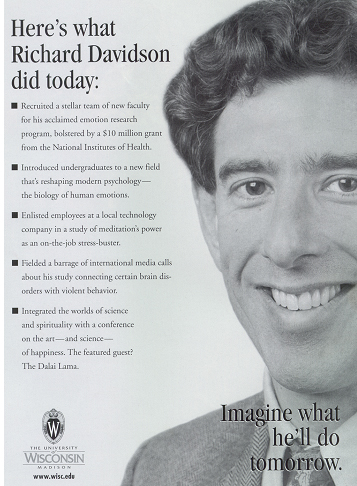Richard Davidson
Davidson is a favorite vehicle for UW spin doctors. He is regularly pictured with the Dalai Lama and presented to the public as a man of compassion.
.jpg)
Consider the UW's fullpage inside front cover promotion of Davidson in the Winter 2001 issue of On Wisconsin:

Wow. What a guy.
At the 2005 meeting of the UW Badgers and Green Bay's UW Trojans, the UW put on a three-minute promo for Davidson's research.
Missing from that expensive piece of propaganda and from the ad above is any mention of Davidson's use of monkeys. So what is it that they are not telling the public?
This is an abstract from a recent paper:
Calling for help is independently modulated by brain systems underlying goal-directed behavior and threat perception. Fox AS, Oakes TR, Shelton SE, Converse AK, Davidson RJ, Kalin NH.
Waisman Laboratory for Functional Brain Imaging and Behavior, University of Wisconsin, Madison, WI 53706, USA.Proc Natl Acad Sci U S A. 2005 Mar 15;102(11):4176-9. Epub 2005 Mar 7.
In primates, during times of need, calling for help is a universal experience. Calling for help recruits social support and promotes survival. However, calling for help also can attract predators, and it is adaptive to inhibit calls for help when a potential threat is perceived. Based on this, we hypothesized that individual differences in calling for help would be related to the activity of brain systems that mediate goal-directed behavior and the detection of threat. By using high-resolution positron emission tomography in rhesus monkeys undergoing social separation, we demonstrate that increased [18F]-fluoro-2-deoxy-D-glucose uptake in the right dorsolateral prefrontal cortex and decreased uptake in the amygdala independently predict individual differences in calling for help. When taken together, these two regions account for 76% of the variance in calling for help. This result suggests that the drive for affiliation and the perception of threat determine the intensity of an individual's behavior during separation. These findings in monkeys are relevant to humans and provide a conceptual neural framework to understand individual differences in how primates behave when in need of social support.
Check out a selection of his papers describing his experiments on monkeys:
Brain Regions Associated with the Expression and Contextual Regulation of Anxiety in Primates. Kalin NH, Shelton SE, Fox AS, Oakes TR, Davidson RJ . Biol Psychiatry . 2005 Jul 23.
Calling for help is independently modulated by brain systems underlying goal-directed behavior and threat perception. Fox AS, Oakes TR, Shelton SE, Converse AK, Davidson RJ , Kalin NH. Proc Natl Acad Sci U S A . 2005 Mar 15;102(11):4176-9. Epub 2005 Mar 7.
The role of the central nucleus of the amygdala in mediating fear and anxiety in the primate. Kalin NH, Shelton SE, Davidson RJ . J Neurosci . 2004 Jun 16;24(24):5506-15.
The primate amygdala mediates acute fear but not the behavioral and physiological components of anxious temperament. Kalin NH, Shelton SE, Davidson RJ , Kelley AE. Related Articles, J Neurosci . 2001 Mar 15;21(6):2067-74.
Cerebrospinal fluid corticotropin-releasing hormone levels are elevated in monkeys with patterns of brain activity associated with fearful temperament. Kalin NH, Shelton SE, Davidson RJ . Biol Psychiatry . 2000 Apr 1;47(7):579-85.
Asymmetric frontal brain activity, cortisol, and behavior associated with fearful temperament in rhesus monkeys. Kalin NH, Larson C, Shelton SE, Davidson RJ . Behav Neurosci . 1998 Apr;112(2):286-92.
Individual differences in freezing and cortisol in infant and mother rhesus monkeys. Kalin NH, Shelton SE, Rickman M, Davidson RJ . Behav Neurosci . 1998 Feb;112(1):251-4.
A new method for aversive Pavlovian conditioning of heart rate in rhesus monkeys. Kalin NH, Shelton SE, Davidson RJ , Lynn DE. Physiol Behav . 1996 Oct;60(4):1043-6.
Lateralized response to diazepam predicts temperamental style in rhesus monkeys. Davidson RJ , Kalin NH, Shelton SE. Behav Neurosci . 1993 Dec;107(6):1106-10.
Lateralized effects of diazepam on frontal brain electrical asymmetries in rhesus monkeys. Davidson RJ , Kalin NH, Shelton SE. Biol Psychiatry . 1992 Sep 1;32(5):438-51.
Why would the UW want to promote Davidson? What is it about his work that is so compelling to the university. The most likely answer is money.
Consider his ability to bring in revenue:
FY 2005:
5P50MH069315-02 Affective Style: Neural And Behavioral Substrates $2,150,464
5R37MH043454-17 Emotional Reactivity And Anterior Brain Asymmetry $449,349
5T32MH018931-16 Training Program In Emotion Research $559,612
FY 2004:
1P50MH069315-01 Affective Style: Neural And Behavioral Substrates $2,132,780
5R37MH043454-16 Emotional Reactivity And Anterior Brain Asymmetry $436,262
5T32MH018931-15 Training Program In Emotion Research $552,886
FY 2003:
P50MH061083-05 Mechanisms Of Mind-Body Interaction: Emotion Interface $2,035,356
R37MH043454-15 Emotional Reactivity And Anterior Brain Asymmetry $423,557
T32MH018931-14 Training Program In Emotion Research $564,939
FY 2002:
5P50MH052354-10 Affective Style – Social and Psychobiological Substrates $767,246
5P50MH061083-04 Mechanisms Of Mind-Body Interaction: Emotion Interface $2,026,417
5R37MH043454-14 Emotional Reactivity And Anterior Brain Asymmetry $411,221
5T32MH018931-13 Training Program In Emotion Research $437,242
FY 2001:
4R37MH043454-13 Emotional Reactivity And Anterior Brain Asymmetry $399,243
5P50MH052354-09 Affective Style – Social and Psychobiological Substrates $752,538
5P50MH061083-03 Mechanisms Of Mind-Body Interaction: Emotion Interface $2,004,344
5R01MH040747-14 Affect, Depression And Brain Asymmetry $424,973
5T32MH018931-12 Training Program In Emotion Research
$403,391
It all makes perfect sense. Sick, but understandable.
Madison's Hidden Monkeys is a joint project of the
Alliance for Animals and the
Primate Freedom Project